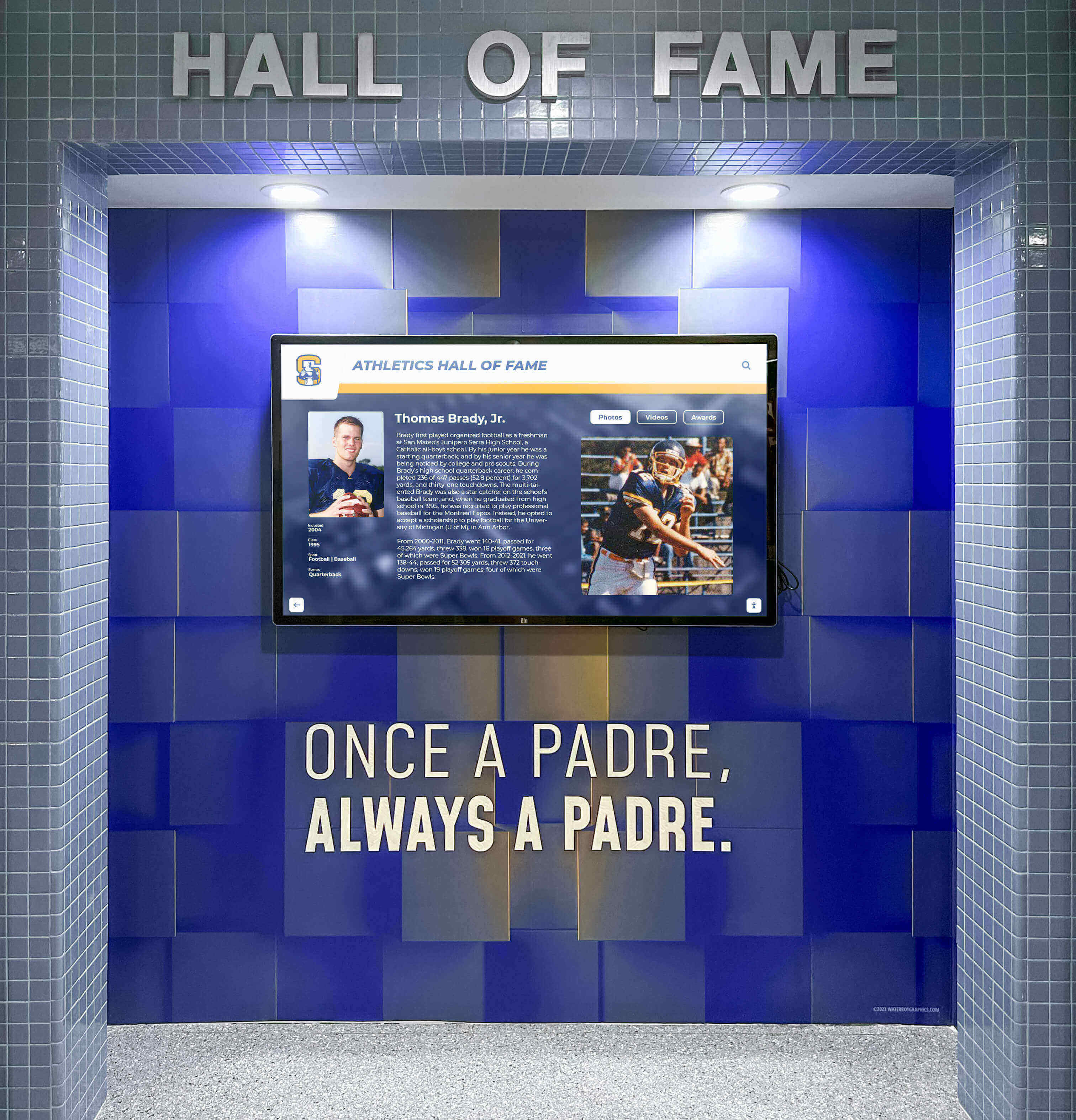Key Takeaways
Explore how interactive touchscreen technology transforms the Florida State Seminoles Hall of Fame experience, celebrating legendary athletes and championships through modern digital recognition displays.
The Florida State Seminoles Athletic Legacy
Before examining how interactive technology enhances recognition, it’s essential to understand the magnitude of achievements that FSU athletics represents and why comprehensive digital solutions have become increasingly valuable for programs with such rich histories.
A Tradition of Championship Excellence
Florida State University’s athletic program has consistently competed at the highest levels across multiple sports, accumulating an impressive collection of achievements:
Football Dominance: The Seminoles football program, particularly during the Bobby Bowden era, established itself as a national powerhouse. From 1987 through 2000, FSU finished in the top five of the national rankings for an unprecedented 14 consecutive seasons, winning three national championships (1993, 1999, and 2013) and producing countless All-Americans and NFL stars.
Baseball Excellence: FSU baseball has claimed multiple College World Series appearances and conference championships, developing professional players and maintaining consistent national rankings. The program’s success represents one of college baseball’s most respected traditions.
Olympic Sports Success: Beyond the high-profile programs, Florida State has excelled in track and field, soccer, softball, and numerous other sports, producing Olympic athletes and championship teams that contribute to the university’s comprehensive athletic excellence.
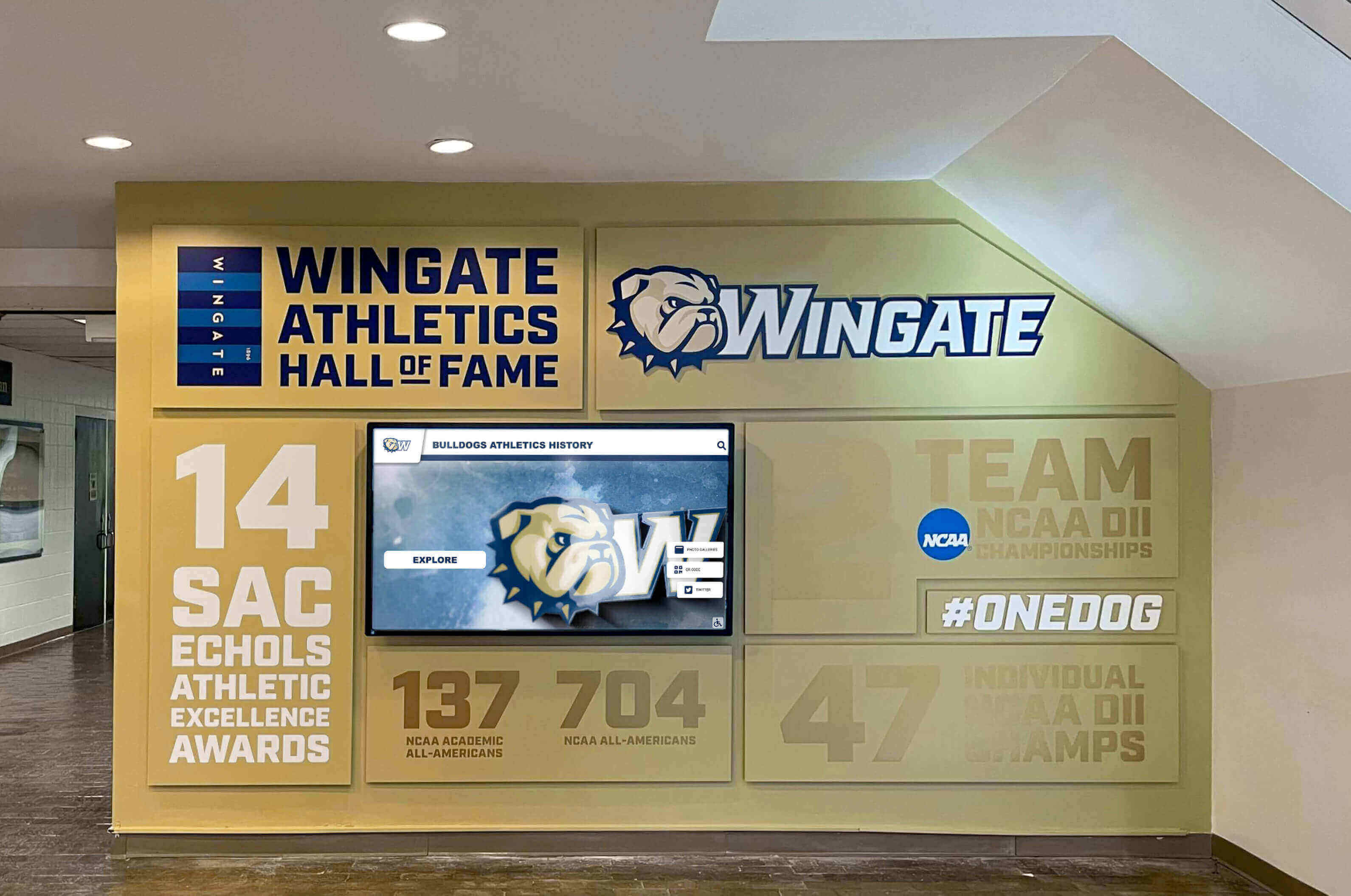
Notable Seminole Hall of Fame Inductees
The Florida State University Athletics Hall of Fame has honored extraordinary individuals who exemplified Seminole excellence. Recent induction classes have included:
2024 Hall of Fame Class:
- Anquan Boldin (Football)
- Lamarcus Joyner (Football)
- Ryan Barthelemy (Baseball)
- Casey Hunter (Softball)
- Phillip Riley (Track & Field)
- Katie Rybakova (Volleyball)
- Bernie Waxman (Supporter)
2025 Hall of Fame Class:
- Jameis Winston (Football - Heisman Trophy winner, National Champion)
- Rashad Greene (Football)
- Bryan Henry (Football)
- Lacey Waldrop (Softball)
- Colleen Quigley (Track & Field)
- Terry Horner (Supporter)
- Bob Braman (Supporter)
These inductees represent just a fraction of the remarkable athletes and contributors who have built the Seminoles’ championship tradition, creating a recognition challenge that interactive digital technology addresses effectively.
The Recognition Challenge for Elite Programs
Programs with Florida State’s level of sustained excellence face unique recognition challenges:
Volume of Achievement: Decades of national-level competition produce hundreds of All-Americans, conference champions, professional athletes, and record holders deserving recognition. Traditional physical displays quickly exhaust available space, forcing difficult decisions about whom to honor.
Evolving Standards: As athletic records continue to be broken and new legends emerge each season, recognition systems must accommodate continuous updates without requiring expensive physical modifications.
Multimedia Storytelling: Today’s audiences expect rich content beyond names and statistics—video highlights, detailed career narratives, and interactive exploration that bring achievements to life.
Accessibility and Engagement: Modern recognition systems should serve multiple audiences: prospective recruits evaluating the program, alumni reconnecting with their era, current students learning institutional history, and visitors experiencing Seminole tradition.
Solutions like interactive touchscreen displays for university athletics address these challenges by providing unlimited recognition capacity, instant content updates, multimedia integration, and engaging user experiences impossible with traditional approaches.
How Interactive Touchscreen Technology Transforms Athletic Recognition
Interactive digital displays represent far more than simply digitizing traditional plaque walls. They fundamentally reimagine how institutions honor achievement and engage audiences with athletic history.
Core Technology Components
Hardware Elements:
- Commercial-grade touchscreen displays (43"-75" or larger)
- 4K resolution for crisp text and photo display
- Optical bonding for durability and visibility
- Professional mounting systems
- Dedicated media player computers
- Network connectivity for content updates
- Professional cable management
Software Capabilities:
- Cloud-based content management systems
- Intuitive administrative interfaces
- Unlimited content capacity
- Advanced search and filtering
- Multimedia integration (photos, videos, documents)
- Analytics tracking engagement
- Mobile and web accessibility
- Customizable branding and design
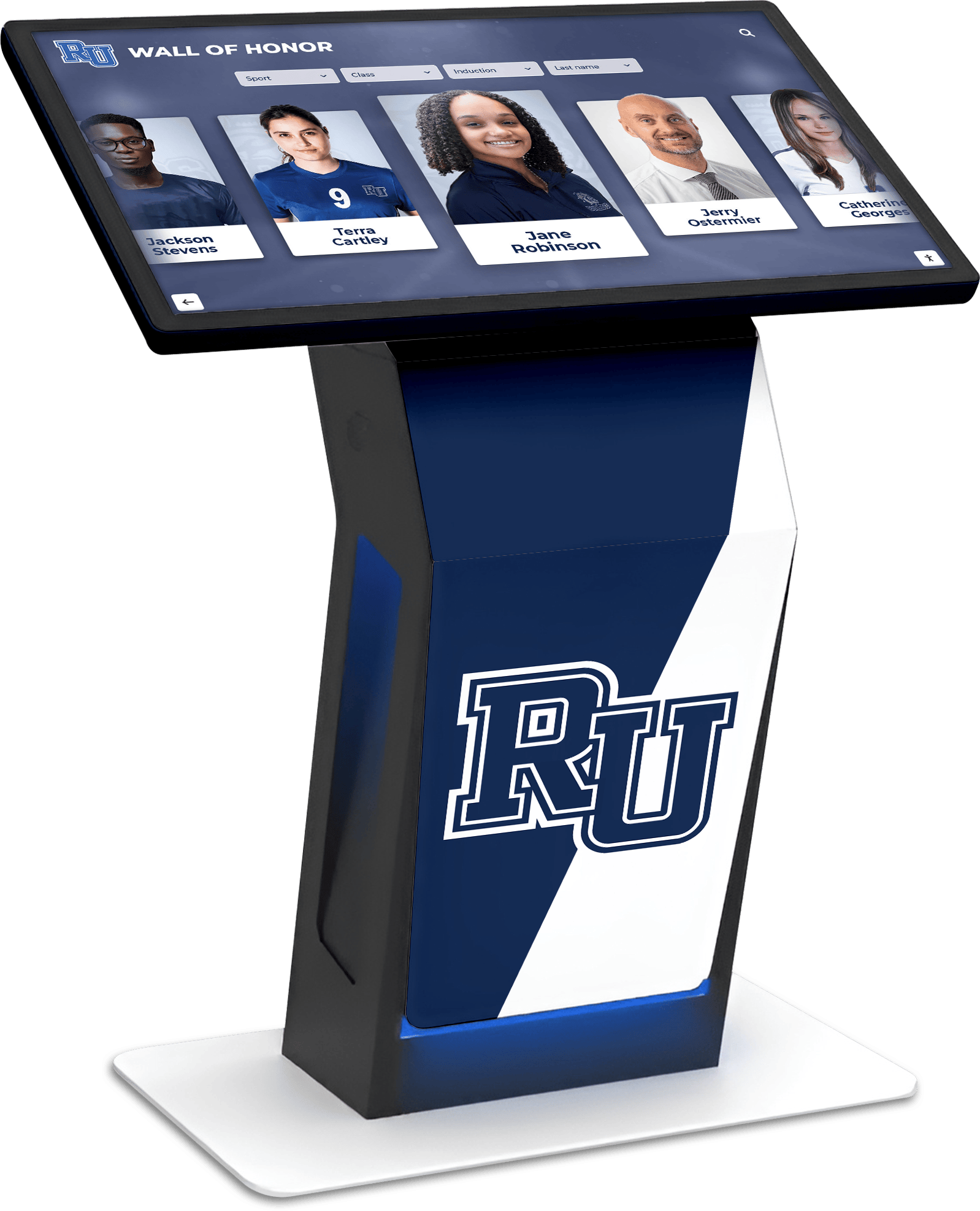
Unlimited Recognition Capacity
Traditional physical displays face fundamental space limitations. A typical trophy case or plaque wall might accommodate 50-100 individual recognitions before exhausting available space. For programs like Florida State with hundreds of worthy honorees, this constraint forces impossible choices.
Interactive touchscreen systems eliminate capacity constraints entirely:
- Comprehensive Historical Coverage: Honor every All-American, conference champion, and record holder from the program’s entire history without space limitations
- Multiple Recognition Categories: Feature separate sections for football, baseball, all sports, supporters, coaches, and championship teams
- Detailed Individual Profiles: Provide extensive biographical information, career statistics, and multimedia content for each inductee
- Ongoing Expansion: Add new inductees annually without physical modifications or capacity concerns
This unlimited capacity ensures that emerging legends like Jameis Winston receive equal prominence alongside earlier Seminole greats, while supporting athletes across all sports gain appropriate recognition rather than being overshadowed by high-profile programs.
Multimedia Storytelling Capabilities
Static plaques can display only limited information—typically a name, achievement, and year. Interactive digital platforms enable rich, multi-layered storytelling that captures the full significance of athletic achievement:
Video Integration:
- Highlight reels from championship games
- Heisman Trophy ceremony footage
- Career retrospectives narrated by broadcasters
- Personal testimonials from inductees
- Archival game broadcasts showing historic moments
- Interviews with coaches and teammates
Photo Galleries:
- Action photography from competitive career
- Award ceremony images
- Team photos from championship seasons
- Current photos showing post-athletic careers
- Historical context images showing era-specific details
- Progression photos from freshman through senior years
Comprehensive Statistical Data:
- Complete career statistics across all seasons
- Season-by-season performance progression
- Record-setting performances with context
- Comparison data showing historical significance
- Team statistics during athlete’s career
- Professional career statistics for those who continued playing
Written Narratives:
- Detailed biographical information
- Career highlights and memorable moments
- Post-graduation achievements
- Personal quotes and reflections
- Coaching testimonials
- Impact on program tradition
Programs implementing comprehensive digital recognition for athletic excellence report that multimedia content significantly increases engagement time, with visitors spending 3-5 times longer exploring digital displays compared to traditional recognition.
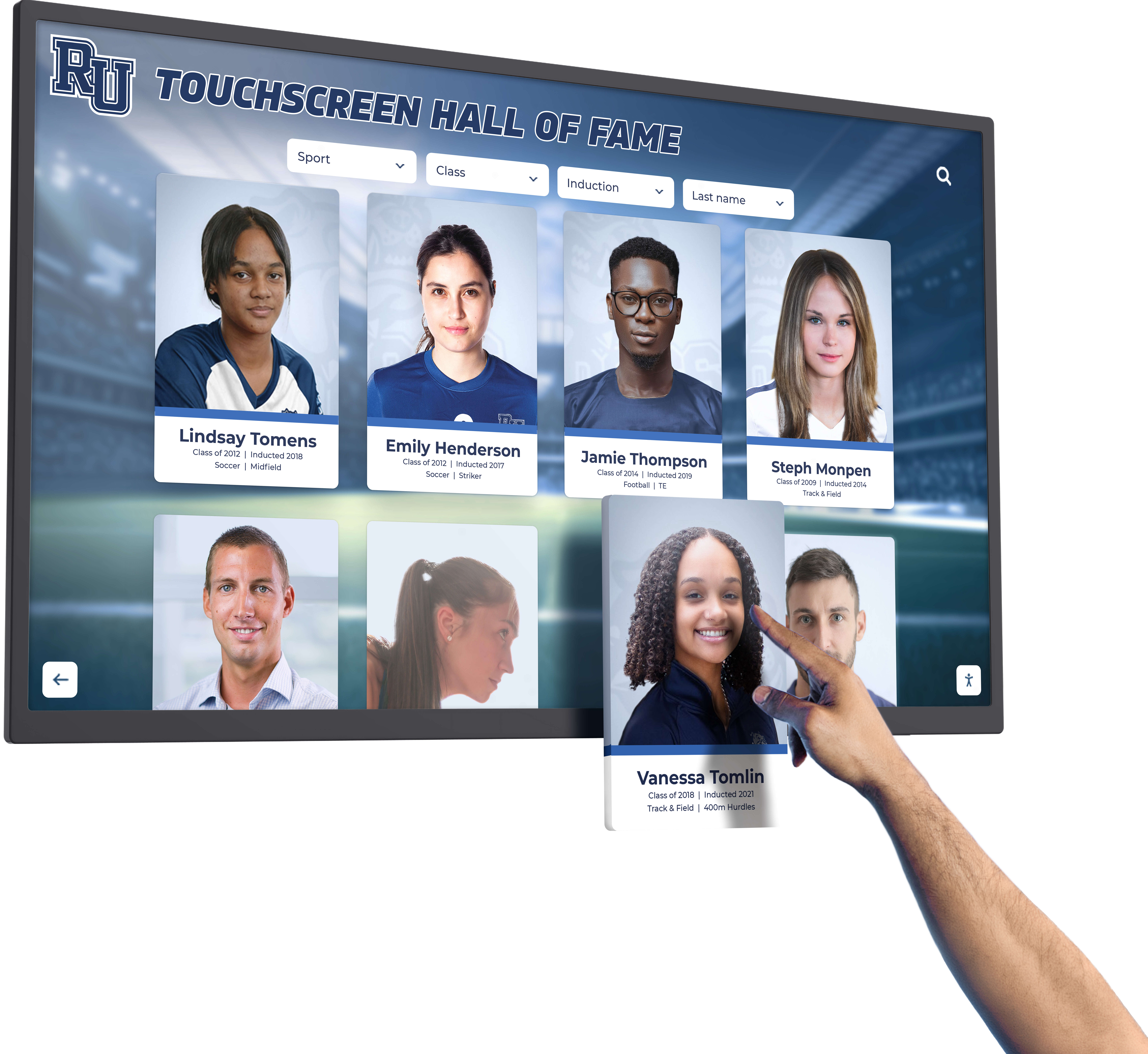
Interactive Exploration and Discovery
Touchscreen interfaces transform passive viewing into active exploration, enabling personalized experiences that serve diverse interests:
Search Functionality: Visitors can instantly locate specific athletes, teams, or achievements by:
- Athlete name search
- Graduation year filtering
- Sport selection
- Achievement type (All-American, Conference Champion, Record Holder)
- Championship team rosters
- Keyword search finding specific accomplishments
Category Browsing: Organized navigation enables discovery through:
- Sport-specific sections (Football, Baseball, All Sports)
- Era browsing (by decade or coaching tenure)
- Achievement categories (National Champions, Heisman Winners, Olympians)
- Position-specific recognition (Quarterbacks, Pitchers, etc.)
- Championship teams by year
- Record holder displays
Featured Content: Dynamic homepage displays showcase:
- Recent inductees gaining immediate visibility
- Anniversary tributes for historic moments
- Birthday recognitions for honorees
- Current season connections to past achievements
- Seasonal themes highlighting relevant achievements
Random Discovery: “Explore” functions present random profiles, encouraging visitors to discover Seminoles they might not specifically search for, creating serendipitous connections with program history.
This interactive functionality particularly benefits prospective recruits researching the program, allowing them to find athletes from their hometown, position, or era of interest, creating personal connections that traditional displays cannot facilitate.
Real-Time Content Updates
Traditional recognition systems require weeks or months to update, involving ordering custom materials, scheduling installation, and paying for professional services. Interactive digital platforms enable instant updates from anywhere:
Immediate Recognition: When Florida State inducts its 2025 Hall of Fame class in September, their profiles can be published to the digital display within minutes of the ceremony conclusion, ensuring timely recognition while excitement remains high.
Evolving Content: As inductees achieve post-athletic success—career milestones, professional championships, community contributions—their profiles can be updated to reflect ongoing accomplishments, keeping recognition current and relevant.
Seasonal Connections: During football season, feature football inductees prominently. During baseball’s College World Series, highlight FSU baseball legends. Dynamic content rotation maintains freshness and relevance throughout the year.
Correction and Enhancement: When additional historical information emerges, photos are discovered, or factual corrections are needed, updates occur immediately rather than requiring expensive physical modifications.
Schools implementing cloud-based digital recognition platforms report that easy content management dramatically increases the frequency of updates, ensuring recognition stays current rather than becoming dated shortly after installation.
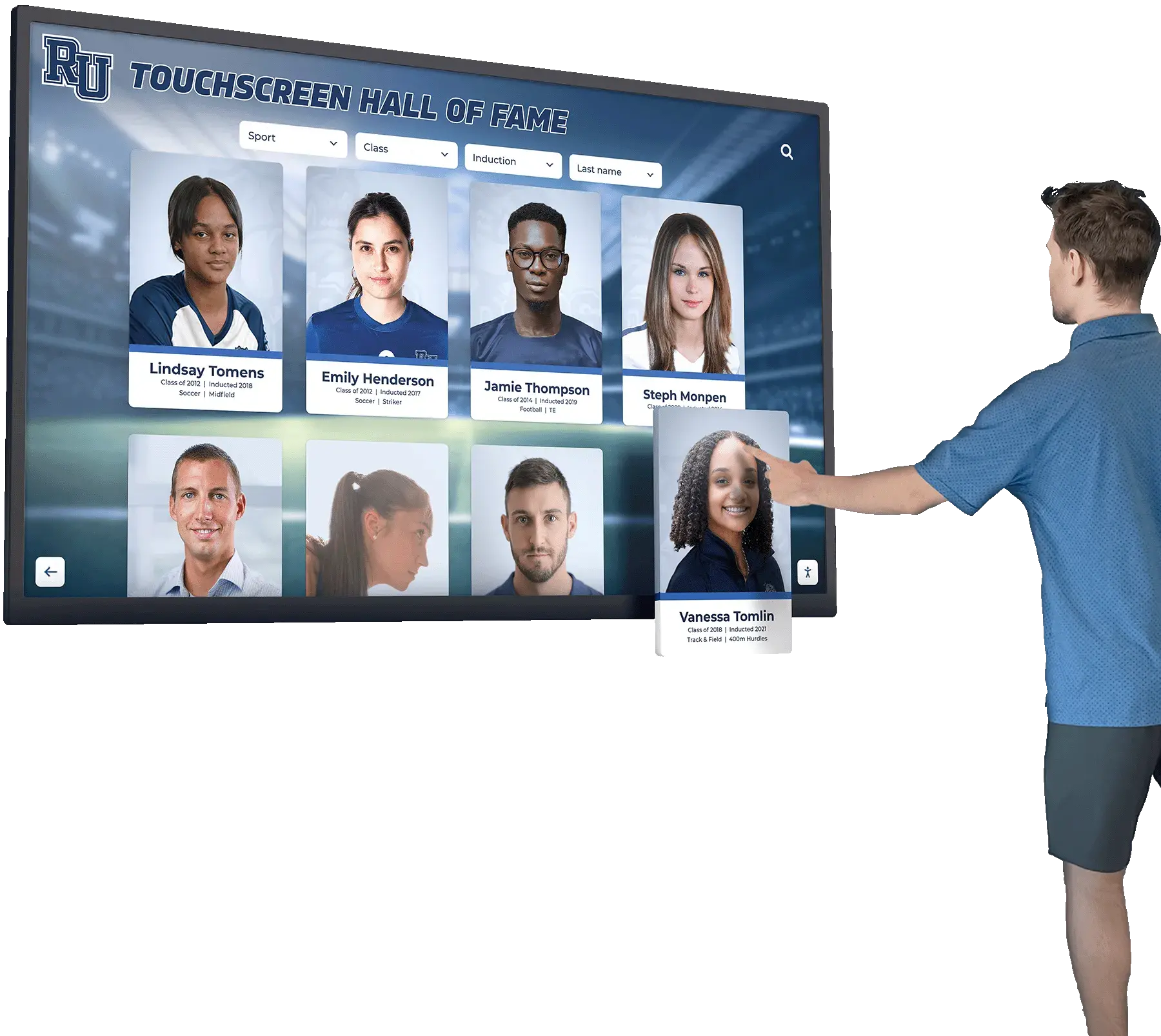
Designing an Effective Interactive Hall of Fame Experience
Successfully implementing touchscreen recognition requires thoughtful design addressing content structure, user experience, visual presentation, and physical installation.
Content Architecture and Organization
Effective information architecture enables intuitive navigation while accommodating diverse content types and user interests:
Primary Navigation Structure:
Sport-Based Organization:
- Football Hall of Fame
- Baseball Hall of Fame
- Olympic Sports Excellence
- Championship Teams
- Coaches and Supporters
Achievement-Based Categories:
- National Champions
- All-Americans
- Conference Champions
- Record Holders
- Professional Athletes
- Academic All-Americans
Era-Based Browsing:
- By Decade (1960s, 1970s, 1980s, etc.)
- By Coaching Era (Bobby Bowden Era, Jimbo Fisher Era, etc.)
- Historic Milestones and Moments
Search and Filter Tools:
- Name search
- Year filters
- Position/event filters
- Achievement filters
- Keyword search
This multi-faceted organization ensures users can navigate according to their specific interests—whether they’re searching for a specific athlete, browsing championship teams from their graduation year, or discovering All-Americans from a particular position.
Individual Athlete Profile Design
Comprehensive profiles transform statistics into compelling narratives:
Profile Components:
- Professional-quality portrait photograph
- Action photography from competitive career
- Complete biographical information (hometown, high school, years at FSU)
- Career statistics with season-by-season breakdowns
- Notable achievements and honors
- Championship team participation
- Career highlights and memorable moments
- Post-FSU career (professional, career, community)
- Video highlights (when available)
- Quotes from the athlete, coaches, or teammates
- Related inductees (teammates, same era, same position)
Visual Hierarchy: Effective profiles present information in layers, with essential details immediately visible and additional content available through scrolling or tapping, preventing information overload while providing depth for interested visitors.
User Experience Principles
Intuitive Navigation: First-time users should successfully navigate the system without instructions. Large touch targets, clear labeling, obvious navigation patterns, and consistent interface design throughout ensure accessibility for all visitors regardless of technical comfort.
Responsive Performance: Touchscreen interfaces must respond instantly to user input. Lag or delay creates frustration and disengagement. Quality systems prioritize smooth scrolling, quick content loading, and seamless video playback.
Visual Appeal: Professional graphic design incorporating FSU’s garnet and gold color scheme, official logos, and brand standards creates visual cohesion with the overall athletic program identity.
Accessibility Considerations:
- Text sizing appropriate for viewing distances
- Color contrast meeting accessibility standards
- Audio descriptions for vision-impaired visitors
- Physical mounting heights accommodating wheelchair users
- Alternative access through mobile or web platforms
Engagement Hooks:
- Featured content drawing attention
- Video autoplay (muted) attracting visual interest
- Random profile suggestions encouraging exploration
- “Did you know?” facts about program history
- Milestone achievements highlighting significance
Organizations implementing best practices for digital athletic recognition report significantly higher engagement when user experience receives careful attention during design phases.
Physical Installation Considerations
Strategic placement maximizes visibility and usage:
Location Options:
Athletic Facility Entrances: Position displays in main entrances to football stadiums, baseball facilities, or athletic department buildings where athletes, recruits, and visitors naturally congregate.
Training Facilities: Install displays in weight rooms, team meeting areas, or athlete lounges where current student-athletes regularly see them, providing daily inspiration and connection to program tradition.
Campus High-Traffic Areas: Place displays in student unions, campus centers, or main administration buildings where broader university community encounters Seminole athletic excellence.
Recruiting Areas: Position premium displays in areas where prospective student-athletes and their families spend time during official visits, showcasing program prestige and tradition.
Multiple Installation Benefits: Unlike traditional physical displays requiring duplication of physical materials, digital systems can present identical content across multiple displays from a single content source, providing consistent recognition throughout campus at minimal additional cost.
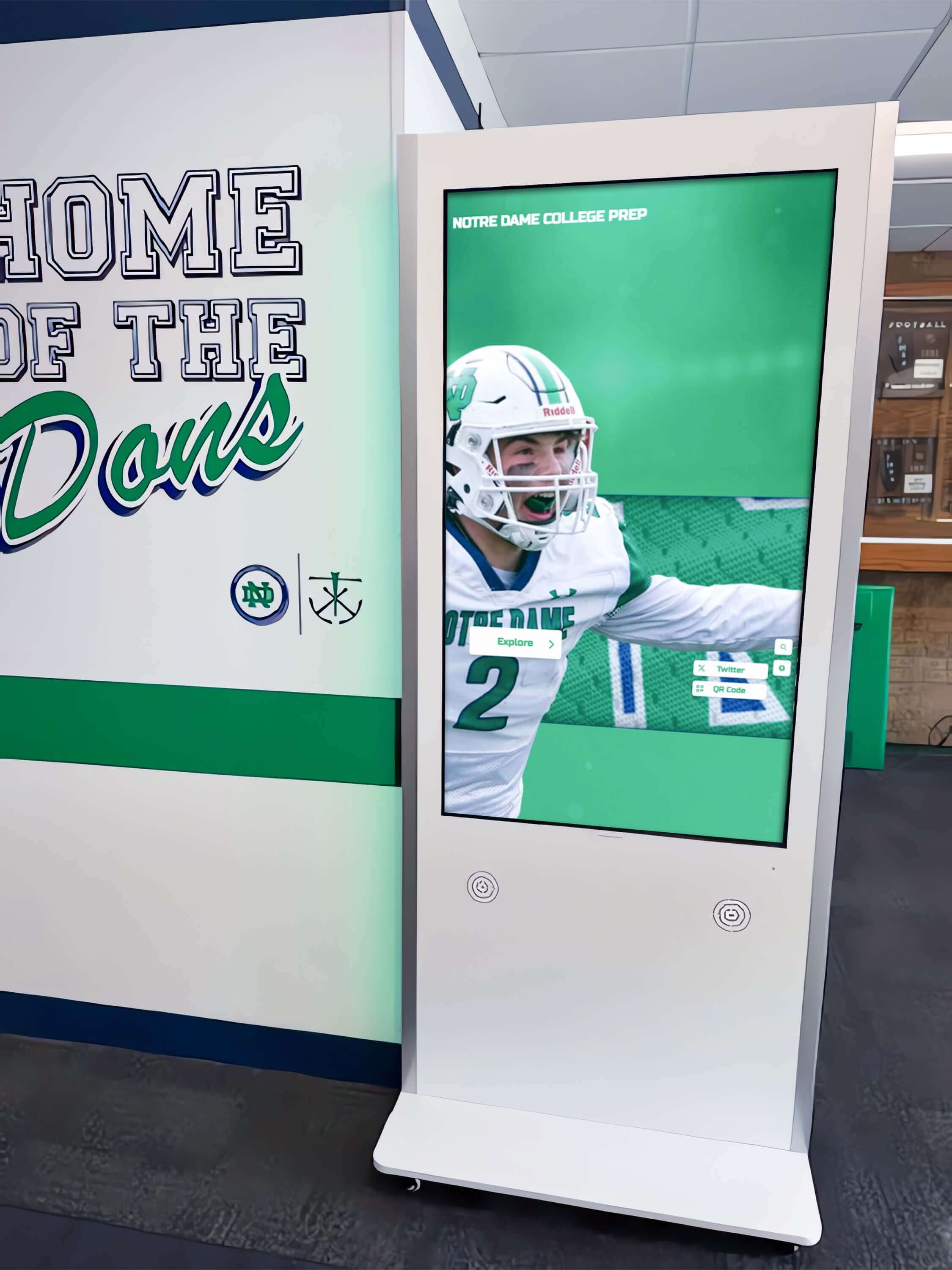
Implementation Considerations for University Athletic Programs
Successfully deploying interactive hall of fame technology requires addressing several practical considerations:
Budget and Investment
Hardware Costs:
- Entry-level system (43-50" display): $6,000-$9,000
- Standard system (55-65" display): $9,000-$15,000
- Premium system (70-85" display): $15,000-$25,000
- Multi-display installations: Scaled pricing with shared infrastructure
Software and Services:
- Cloud-based content management platform: $2,000-$5,000 initial setup
- Annual licensing and support: $1,200-$3,000
- Content development assistance: $2,000-$10,000 depending on scope
- Training and implementation support: Often included in initial setup
Long-Term Value: While initial investment exceeds traditional physical displays, digital systems eliminate ongoing per-update costs. Most programs achieve cost neutrality within 3-5 years while gaining dramatically enhanced capabilities.
Funding Sources:
- Athletic department operating budgets
- Booster club contributions
- Alumni donations specifically for recognition
- Facility improvement capital campaigns
- Naming opportunities for major donors
- Memorial contributions honoring specific individuals
Programs implementing affordable digital recognition solutions demonstrate that effective systems are accessible to programs at various budget levels through phased implementation and strategic planning.
Content Development Process
Creating comprehensive content for decades of athletic excellence requires systematic approaches:
Historical Research:
- Athletic department archives and records
- Media guides and yearbooks
- Newspaper archives and historical coverage
- Athletic communications office resources
- Alumni association contacts
- Retired athletic department staff interviews
- Existing hall of fame materials and documentation
Photo and Video Collection:
- Official athletic photography archives
- Broadcast footage from championship games
- Alumni personal photo contributions
- Historical society and archive resources
- Professional photography for living inductees
- Video interview production for oral history
Writing and Profile Development:
- Biographical research and fact verification
- Statistical compilation and verification
- Career narrative development
- Achievement context and significance
- Post-athletic career research
- Quote collection from athletes and coaches
Quality Assurance:
- Fact-checking all information
- Photo rights verification
- Consistent formatting and style
- Proofreading and editing
- Review by athletic communications staff
- Approval processes for official publication
Schools implementing comprehensive content strategies for digital recognition recommend starting with recent inductees where information is readily available, then gradually expanding historical coverage over time rather than delaying launch until complete historical content is developed.
Technical Requirements
Network Infrastructure:
- Reliable internet connectivity for content updates
- Adequate bandwidth for video streaming
- Network security meeting university IT standards
- Remote management capabilities for troubleshooting
Facility Requirements:
- Electrical power at display locations
- Appropriate mounting surfaces or floor space
- Environmental controls (temperature, humidity)
- Lighting consideration to minimize glare
- Physical security (high-traffic vs. controlled access areas)
Support and Maintenance:
- Content management training for staff
- Technical support from vendor
- Hardware warranty and service plans
- Software updates and feature enhancements
- Analytics access for engagement tracking
Integration with Broader Recognition Programs
Interactive displays function most effectively as part of comprehensive recognition strategies:
Physical Integration: Combine digital displays with complementary physical elements like trophy cases, championship banners, and traditional plaques, creating multi-dimensional recognition experiences that honor tradition while embracing innovation.
Digital Ecosystem Connection: Link touchscreen displays to athletic department websites, mobile apps, social media platforms, and virtual tour experiences, creating consistent recognition across all channels.
Recruitment Integration: Incorporate display content into recruiting presentations, official visit experiences, and digital recruiting materials, leveraging recognition to demonstrate program excellence and tradition.
Alumni Engagement: Provide web-based access to hall of fame content, enabling alumni to explore recognition remotely, share profiles on social media, and maintain connections to program achievements.
Fundraising Connection: Use recognition displays to acknowledge donors, create naming opportunities, and demonstrate stewardship of philanthropic support, integrating athletic and development office objectives.
Institutions implementing comprehensive digital recognition ecosystems report that integrated approaches deliver significantly greater value than standalone installations.
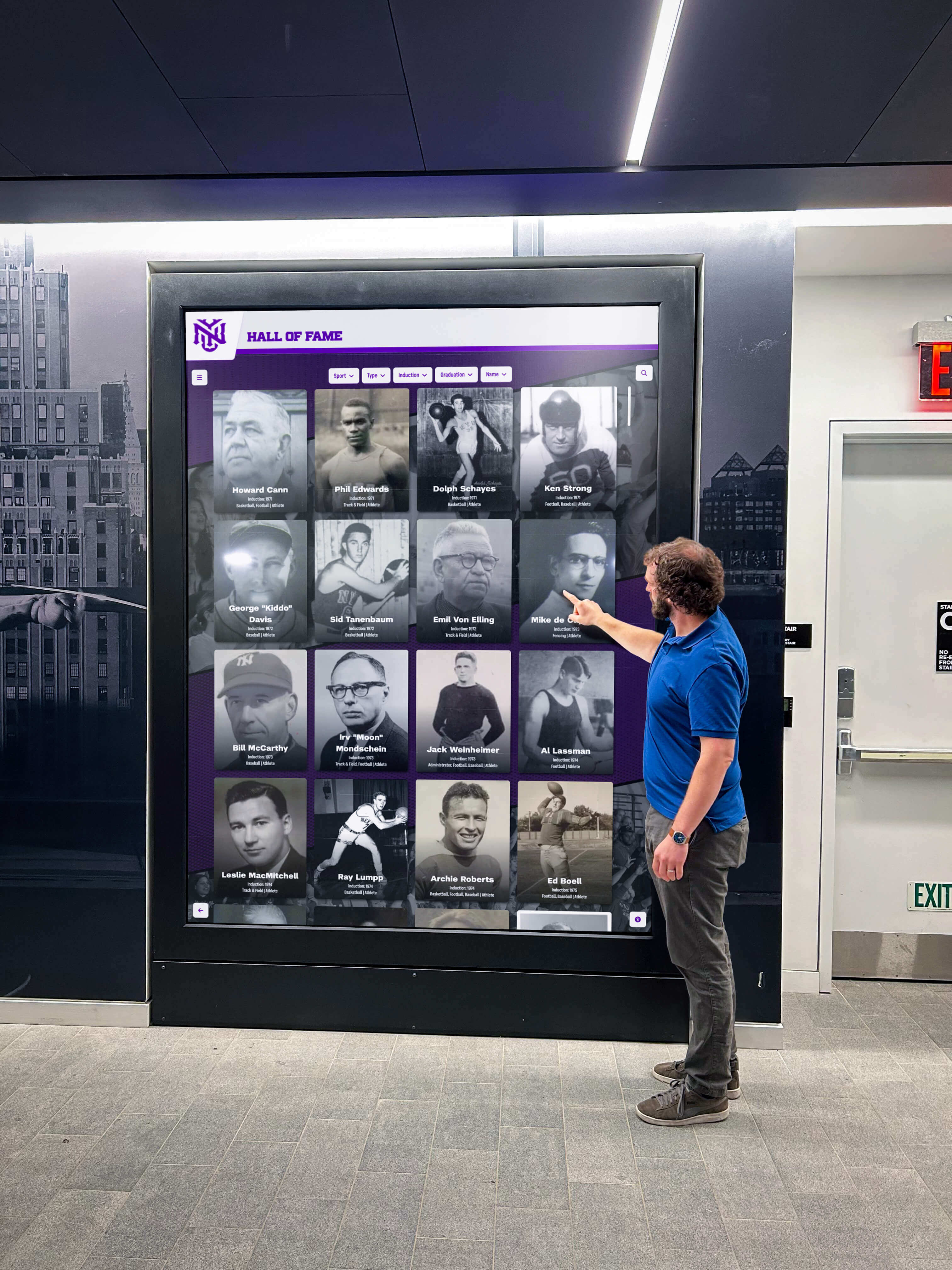
Benefits Beyond Recognition: Strategic Value for Athletic Programs
Interactive hall of fame displays deliver value extending well beyond simply honoring past achievements:
Recruitment Advantages
Prospective student-athletes evaluate programs partially through visible evidence of tradition and player development. Interactive displays provide:
Proof of Excellence: Comprehensive recognition demonstrates sustained success across decades, signaling program quality and competitive environment to recruits and their families.
Player Development Evidence: Displays showcasing numerous All-Americans, professional athletes, and academic achievers demonstrate the program’s ability to develop talent at the highest levels.
Personal Connection Opportunities: Recruits can search for athletes from their hometown, high school, or position, creating personal connections to program legacy that traditional displays cannot facilitate.
Family Engagement: Interactive displays give parents and family members productive activities during campus visits while independently reinforcing program excellence messages.
Social Proof: The quantity and quality of recognized achievements provides social proof of program prestige that influences decision-making when recruits compare multiple scholarship offers.
Current Student-Athlete Motivation
Recognition displays serve as daily reminders of program standards and achievable excellence:
Visible Standards: When current athletes regularly see displays honoring 1,000-point scorers, All-Americans, or championship teams, those achievements transform from abstract aspirations to concrete, attainable goals.
Modeling Excellence: Recently graduated athletes who current players knew personally demonstrate that excellence is achievable through dedication and development within the program.
Program Pride: Comprehensive recognition of program achievements builds collective pride and institutional identity, strengthening team culture and commitment.
Legacy Awareness: Understanding program history creates responsibility to uphold standards and contribute to ongoing tradition, fostering long-term commitment rather than transactional relationships.
Alumni Connection and Engagement
Interactive displays strengthen bonds between alumni and their alma mater:
Representation and Validation: Alumni seeing their achievements recognized experience validation and continued connection to the institution, supporting ongoing engagement and philanthropy.
Reunion Experiences: Returning alumni can explore their era’s achievements, find former teammates, and relive career highlights through interactive displays during reunion visits.
Virtual Access: Web-based versions enable alumni to access recognition remotely, sharing profiles with family and maintaining connection regardless of geographic distance.
Ongoing Updates: As alumni achieve post-graduation success, updated profiles demonstrate continued institutional interest and pride in their accomplishments beyond athletic careers.
Intergenerational Connection: Parents and grandparents who are alumni can show current students their own recognition, creating family legacy connections that strengthen multi-generational institutional relationships.
Programs implementing strategic alumni engagement through digital recognition report measurable increases in alumni event participation, giving rates, and overall engagement metrics.
Institutional Brand Building
Recognition displays contribute to broader institutional reputation and brand objectives:
Excellence Demonstration: Comprehensive athletic achievement recognition signals institutional commitment to excellence across all dimensions, supporting academic reputation as much as athletic prestige.
Technology Leadership: Modern interactive displays demonstrate innovation and forward-thinking institutional culture, countering outdated perceptions and appealing to technology-native generations.
Campus Vibrancy: Engaging digital experiences contribute to overall campus atmosphere and energy, supporting student satisfaction and institutional appeal.
Media and Public Relations: Recognition displays provide backdrops for media interviews, press conferences, and promotional content, consistently reinforcing program excellence in visual communications.
Competitive Differentiation: Interactive recognition creates memorable experiences that differentiate the institution during recruitment, donor cultivation, and competitive positioning against peer institutions.
Future Trends in Digital Athletic Recognition
Interactive touchscreen technology continues evolving, with emerging capabilities expanding what’s possible:
Augmented Reality Integration
Future systems may incorporate AR features enabling visitors to use smartphones to see:
- Virtual trophy displays overlaid on physical spaces
- Animated athlete figures demonstrating signature moves
- Historical game footage triggered by physical locations
- Interactive team formations and play diagrams
Artificial Intelligence Enhancement
AI capabilities could enable:
- Natural language search (“Show me Heisman Trophy winners”)
- Automated content generation for new inductees
- Personalized content recommendations based on browsing behavior
- Intelligent photo organization and tagging
- Automated statistical comparisons and analysis
Social Media Integration
Enhanced social sharing could include:
- One-tap profile sharing to social platforms
- Custom graphics generation for sharing
- QR codes linking physical and digital recognition
- Social media wall displays showing shared content
- Engagement tracking across channels
Gamification Elements
Interactive elements could include:
- Trivia challenges about program history
- Prediction competitions during current seasons
- Virtual scavenger hunts across multiple displays
- Achievement collection for frequent users
- Leaderboards for engagement
Extended Reality Experiences
Virtual and extended reality could enable:
- Virtual tours of hall of fame from anywhere
- 360-degree video experiences of historic moments
- Virtual reality game recreations
- Holographic athlete presentations
- Immersive championship team experiences
Conclusion
The Florida State Seminoles athletic program has built one of college sports’ most remarkable legacies through decades of championship excellence, legendary athletes, and unforgettable moments. This extraordinary tradition deserves recognition technology that matches its significance—comprehensive, engaging, and inspiring.
Interactive touchscreen hall of fame displays transform traditional recognition from static plaques into dynamic digital experiences that honor past achievements while inspiring future excellence. Unlimited capacity ensures every worthy Seminole receives appropriate recognition. Multimedia storytelling brings achievements to life through video, photos, and detailed narratives. Interactive exploration enables personalized discovery serving diverse audiences from recruits to alumni to casual visitors.
For athletic programs at Florida State’s competitive level, modern recognition technology delivers value extending beyond honoring past achievements. Strategic benefits include recruitment advantages, current athlete motivation, alumni engagement, and institutional brand building that justify investment through multiple value streams.
Whether honoring Heisman Trophy winners like Jameis Winston, celebrating championship teams, recognizing Olympic athletes, or acknowledging the supporters who enable excellence, interactive digital recognition provides the platform Seminole tradition deserves—professional, comprehensive, and inspiring.
Solutions like those from Rocket Alumni Solutions enable institutions to honor athletic excellence through purpose-built platforms designed specifically for educational recognition rather than generic digital signage. Cloud-based content management, unlimited recognition capacity, and intuitive interfaces empower athletic communications staff to maintain current, comprehensive recognition without requiring technical expertise.
The Seminole legacy continues growing with each season, each championship, and each exceptional athlete. Modern recognition technology ensures this remarkable tradition receives the celebration it deserves while inspiring the next generation of Florida State greatness.
Ready to transform athletic recognition at your institution? Contact Rocket Alumni Solutions to explore how interactive touchscreen hall of fame technology can celebrate your program’s achievements while building stronger connections across your entire athletic community. Your legends deserve recognition that matches their excellence—permanent, professional, and powerful.
